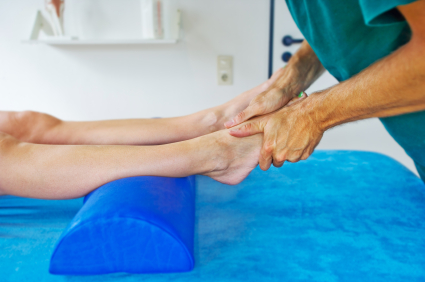As you watch your a physical therapist poke, prod, and push your child to their physical limit in rehabbing a sports injury, do you ever say to yourself, "What the heck is he doing to my child and is this going to work?"
My stock response as a physical therapist, of course, is your child is doing PT in order to recover from a sports injury, and, yes, in most cases, PT works.
But to understand why, it is helpful to break a physical therapy visit into it its major parts so you, as a parent, can understand how and why physical therapy decisions and recommendations are made, such as, for example, "Use ice 3x a day for 20 minutes" to "Your child can walk without crutches, but only around the house."
5 components
Every physical therapy visit can be broken down into 5 basic parts:
- Subjective
- Objective
- Treatments
- Assessment
- Plan
By following this progression at each session, a PT help your injured athlete recover safely from a sports injury.
Subjective
A PT is constantly gathering subjective information from the patient by asking such questions as "How is your knee doing?" or "Is it still hurting while you sleep?" PTs like to gather this information at the beginning and then sometimes throughout the therapy process.
Answers to questions about pain, activity level, sleeping patterns, ability to walk, or general well-being give a PT two important pieces of information: First, how the patient is responding to treatmen, and, second, what needs to be tested, depending on whether there has been progress or regression.
Objective
If you ever see a physical therapist pulling out a grip gauge, a plastic instrument to measure the knee, or a tape measure, they are making objective measurements of such things as:

- swelling
- range of motion
- strength
- balance, and
- core stability.
For example, if an athlete says, "I am doing great, doesn't hurt to walk, I am fine," but objective testing reveals a very weak quadriceps muscle, that the knee is swollen, and he walks with a limp, the conflicting information will rule out beginning the athlete on lunges or jumping exercises, even if the doctor's protocol says they should be doing a particular exercise at Week 5.
Treatments
Simply put, this is what the PT either does to the patient or instructs the patient to do.
Physical therapists will often manually push a tight joint, do a cross-friction massage to an area where the athlete is experiencing tendonitis, or put sustained pressure over a trigger point. Other common tools utilized are ultrasound, e-stim, heat/cold, and perhaps laser treatment along irritate tissue. Such hands-on techniques are critical early in therapy process, and one reason why your child is doing PT three times a week at the start.
During the early stages of injury rehab, physical therapy is critical in controlling swelling, and minimizing further joint damage. After treatment during the acute injury phase has been completed, the pace of recovery will largely be up to the athlete, with the physical therapist prescribing a progression of exercises to help a young athlete get back to the playing field.
Often times, it may seem as if a PT is just saying, "Do these exercises" only to fill up an hour; in reality, they are all prescribed for a reason. Every physical therapist is a musculoskeletal specialist, meaning they know how every muscle, tendon, nerve, bone, joint, etc. interacts. If one part is damaged, only certain activities are appropriate in congruence with the objective information they tested for. Once the physical therapist determines that a body part is ready, the PT can have the athlete progress to the next step.
Assessment
After each treatment, a PT will sit down at their computer and figure out "how did this PT session go?" They will look over the overall subjective responses, including what was said before and during therapy, and compare that with the objective measurements. This gives the PT an overall impression of where you child is in the rehabilitation process.
Plan
After all the questions, testing, exercises, and analyzing, it comes time to ask what's next. Even before your child heads out the door, the therapist is mulling over the answer to that question. Based upon what the athlete says, what happens at the next visit may the same or vary a little bit. If the athlete says at the next session something like "My knee is sore, but I am walking better" it may mean that it is probably okay to push her more. If, on the other hand, she reports that "My knee is more swollen and now I have radiating pain in my foot," what happens at that visit may be to take a step back and re-assess the treatment plan.
Second in a series
Keith Cronin is a physical therapist in the St. Louis area and a MomsTeam expert.
Posted December 7, 2011, updated April 6, 2015








